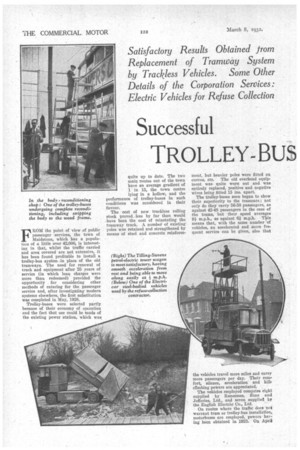Successful TROLLEY-BUS EXPERIENCE at Maidstone
Page 94

Page 95

If you've noticed an error in this article please click here to report it so we can fix it.
Satisfactory Results Obtained from Replacement of Tramway System by Trackless Vehicles. Some Other Details of the Corporation Services: Electric Vehicles for Refuse Collection
FROM the point of view of public passenger services, the town of Maidstone, which has a population of a little over 42,000, is interesting in that, whilst the traffic carried and area covered are not extensive, it has been found profitable to install a trolley-bus system in place of the odd tramways. The need for renewal of track and equipment after 25 years of service (in which loan charges were more than redeemed) provided the opportunity for considering other methods of catering for the passenger service and, after investigating modern systems elsewhere, the first substitution was completed in May, 3928.
Trolley-buses were selected partly because of their economy of operation and the fact that use could be Made of the existing power station, which was quite up to date. The two main routes out of the town have an average gradient of 1 in 15, the town centre lying in a hollow, and the performance of trolley-buses in such conditions was considered in their favour.
The cost of new trackless rolling stock proved less by far than would have been the cost of reinstating the tramway track. A number of existing roles was retained and strengthened by means of steel and concrete reinforce ment, but heavier poles were fitted on curves, etc. The old overhead equipment was quite worn out and was entirely replaced, positive and negative wires being fitted 15 ins. apart.
The trolley-buses soon began to show their superiority to the tramcars; not only do they carry 56-58 passengers, as against 42-48 passengers in the case of the trams, but their speed averages 91t m.p.h., as against 61 m.p.h. This means that, with the same number 'of vehicles, an accelerated and more frequent service can be given, also that the vehicles travel more miles and carry more passengers per day. Their comfort, silence, acceleration and billclimbing powers are appreciated.
The vehicles employed comprise eight supplied by Ransomes, Sims and Jefferies, Ltd., and seven supplied hi the English Electric Co., Ltd.
On routes where the traffic does not warrant tram or trolley-bus installation, motorbuses arc employed, powers having been obtained in 1923. On April 7th, 1924, buses commenced operation between London Road and Penenden Heath, Tilling-Stevens petrol-electric vehicles being bought for., the purpose ; they are still in service. Other routes were subsequently opened up.
As things are at present, in addition to the three petrol-electrics already mentioned, there are two 35-seaters, in troduced in August, 1924, and three central-entrance 30-seaters commissioned in May, 1926. Apart from these petrol-electric vehicles there are two Tilling-Stevens Express gear-driven buses that were purchased in June, 1928, and four Leyland Lion vehicles, Purchased in June, 1929.
An order has been placed with T.S. Motors, Ltd., to supply two new 32-33seaters with Crossley 65 b.h.p. sixcylindered oil engines and Beadle bodywork. These are to take the place of the three Tilling-Stevens 1924 petrolclectries, and so soon as adequate experience of the oil engine has been obtained a decision will be made about replacing the five next-oldest machines in the fleet.
One or two features of the system are unusual. For example, workmen and workwomen—in fact, all eligible to
contribute to the National Health Insutance scheme—are qualified to apply for the issue of a token, production of which on a corporation vehicle entitles the owner to receive a half-price workman's ticket any week-day 'up to 9 a.m. (the return half usable_ after noon), or 'between noon and 2 p.m.
. Another interesting fact is that, to Obtain the desired revenue rate per passenger-mile, whilst providing convenient stages, higher fares are charged on certain outward (uphill) journeys than on the inward journeys. Thus a yield of lid. is obtained by -charging Id. inward and 1id. outward. The unexpected result is that more passengers ride inward, thinking they are getting a cheap fare.
The corporation has two Dennis fireengines and" two lorries of the same make used by the borough surveyor. In addition, the electricity department 'emPloys a 3i-ton Electricar vehicle, a Thornyeroft 2/-tonner, two Chevrolet vehicles, one Jewett van and two small Morris vans.
Refuse collection is carried out under contract by Mr. W. Venn Carr, whose family has catered for the work since 1890. Horses were employed until November, 1928, when Mr. Carr purchased five Electricar 30-cwt. 6-1-culic yd. refuse collectors. These have Exide Ironclad batteries and they collect 9,000 to 10,000 tons of refuse annually at a power cost per vehiclemile, including plant charges, of 1,23d., the power cost per ton being 2.006d They are highly satisfactory.












































































































































































